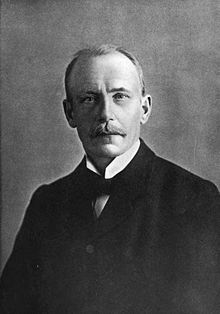Loading AI tools
British politician (1853–1934) From Wikipedia, the free encyclopedia
Sydney Charles Buxton, 1st Earl Buxton, GCMG, PC (25 October 1853 – 15 October 1934) was a radical British Liberal politician of the late 19th and early 20th centuries.[1][2] He also served as the second Governor-General of South Africa from 1914 to 1920.
The Earl Buxton | |
|---|---|
 | |
| 2nd Governor-General of South Africa | |
| In office 1914–1920 | |
| Monarch | George V |
| Prime Minister | Louis Botha Jan Smuts |
| Preceded by | The Viscount Gladstone |
| Succeeded by | Prince Arthur of Connaught |
| President of the Board of Trade | |
| In office 14 February 1910 – 11 February 1914 | |
| Monarchs | Edward VII George V |
| Prime Minister | H. H. Asquith |
| Preceded by | Winston Churchill |
| Succeeded by | John Burns |
| Postmaster General | |
| In office 1905–1910 | |
| Monarch | Edward VII |
| Preceded by | The Lord Stanley |
| Succeeded by | Herbert Samuel |
| Personal details | |
| Born | 25 October 1853 London, England, UK |
| Died | 15 October 1934 (aged 80) Newtimber, West Sussex, England, UK |
| Political party | Liberal |
| Spouse(s) | Constance Mary Lubbock (1882–1892; her death); 3 children Mildred Anne Smith (1896–1934; his death); 3 children |
| Alma mater | Trinity College, Cambridge |
| Profession | Member of Parliament |


Buxton was the son of Charles Buxton[3] and grandson of social reformer Sir Thomas Fowell Buxton, 1st Baronet. His mother was Emily Mary, daughter of the physician and traveller Sir Henry Holland, 1st Baronet. He was born in London and educated at Clifton College and Trinity College, Cambridge,[4] and was a member of the London School Board from 1876 to 1882.
In 1880, Buxton became prominent in political circles by the publication of his Handbook to the Political Questions of the Day, a work which eventually went through 11 editions. That same year, he ran for Parliament for Boston, but lost. However, he became an MP in 1883 by winning a by-election in Peterborough. He was defeated in the 1885 general election, but returned to Parliament the very next year, representing Poplar. He would represent this constituency in Parliament until 1914.[1]
From 1892 to 1895, Buxton served as Under-Secretary of State for the Colonies. In 1905, he earned his first Cabinet post, that of Postmaster-General. In this capacity he introduced such services as penny postage to the United States, the Canadian magazine post, and cheap postage for the blind. In 1910, Buxton was named president of the Board of Trade; in this position he oversaw the passage or amendment of many trade and commerce laws. Upon the sinking of the RMS Titanic in 1912, he asked Lord Loreburn, the Lord Chancellor, to appoint a commission of inquiry into the disaster. This commission eventually came to be headed by Lord Mersey.[1]
In February 1914, Buxton was appointed Governor-General of South Africa, and on 11 May of that year he was raised to the peerage as Viscount Buxton, of Newtimber in the County of Sussex.[5] A revolt by some of the South African populace on the outbreak of the First World War temporarily threatened his safety, but the country's Prime Minister, General Louis Botha, immediately attached the Union of South Africa to Britain. Thereafter, Lord Buxton and General Botha formed an effective partnership, planning and executing South African actions in the war, including the invasion of the neighbouring German colony of South West Africa. Lord Buxton travelled widely throughout South Africa, and endeared himself to the people. Upon his retirement in 1920, the people demonstrated their affection for him. He continued his interest in South African affairs after returning to England, serving as president of the African Society from 1920 to 1933.[citation needed]
He was created Earl Buxton on 8 November 1920,[6] and continued to be a member of the Liberal Party, often supporting his close friend and colleague Sir Edward Grey. In his later years, he had to undergo amputation of his leg due to a knee injury sustained earlier in his life.
Lord Buxton was twice married, firstly in 1882 to Constance Mary Lubbock (died 1892), second daughter of John Lubbock, and secondly in 1896 to Mildred Anne Smith, elder daughter of Hugh Colin Smith, governor of the Bank of England, of Mount Clare, Roehampton, a sister of the banker Vivian Smith and of Admiral Sir Aubrey Smith, RN.[1]
By his first wife, he had two sons and one daughter, of whom the sons both died in his lifetime. By his second wife, he had one son and two daughters, of whom the son and the elder daughter died in his lifetime.[1]
By his first wife, Constance Mary Lubbock (died 3 November 1892):[7]
By his second wife, Mildred Anne, Countess Buxton DBE JP (1866–1955):[7]
Since all his sons died unmarried in his lifetime, his titles became extinct at his death. Earl Buxton was survived by his second wife Mildred (died 1955) and his youngest daughter Lady Althea Eliot (died 2004), and by eight grandchildren including the future Duke of Grafton (1919–2011).
Seamless Wikipedia browsing. On steroids.
Every time you click a link to Wikipedia, Wiktionary or Wikiquote in your browser's search results, it will show the modern Wikiwand interface.
Wikiwand extension is a five stars, simple, with minimum permission required to keep your browsing private, safe and transparent.